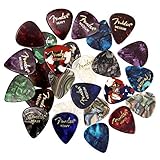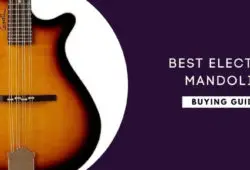As tiny as they are, picks have a considerable influence on how your instrument sounds and how playable it will be.
The best mandolin picks are very comfortable, feel great in your hands, and will bring out the true voice of your instrument.
Let’s discuss this a little further.
Table of Contents
Our Picks for Best Mandolin Picks
1. D’Addario Chris Thile Signature Pick Review: Best Mandolin Pick Overall
Made from Casein, this D’Addario pick looks and feels like a tortoise shell which is the best way to identify the best picks.
Seeing as it was designed in partnership with Chris Thile, this plectrum guarantees the ultimate combination of comfort, tone, and playability.
The heavy-duty pick has a wide triangular shape and measures 1.4mm in thickness.
The triangle shapes offer great control, while the beveled tip allows for excellent glide and articulation.
This premium pick gives the mandolin player access to a tone that’s textured and balanced.
- Excellent comfort and playability.
- Provides natural and sharp tones.
- Great durability.
- It may deform after a while.
2. Golden Gate MP-12 Pick Review: Best Durable Mandolin Pick
Made from nitrocellulose, these Golden Gate picks are heavy and extra-thick, measuring 1.5mm in thickness.
The heavy thickness allows this pick to have an excellent dynamic range, so you are assured of great sound and maximum durability.
The extra-rich fat tone produced would be perfect for moments when mandolin players might want that extra volume.
It comes in a triangular shape with rounded edges, making it the best pick for rapid tremolo. The plectrum allows for a powerful drive with immediate note attacks that are clean and clear.
At the same time, the rounded triangle design of this Golden Gate pick will feel right in your hands no matter how you hold it.
- Excellent for speed picking.
- Incredibly clear tone.
- Very strong and durable.
- It can be challenging to maintain a grip.
3. Fender Premium Picks Review: Best Value Pack Mandolin Picks
Fender is an excellent brand whose flatpicks guarantee comfort and high-performance flexibility for all types of players.
These Fender packs include different picks, so you get to sample all their styles and shapes.
It would be an excellent option for a beginner or any player who is yet to find the perfect pick that entirely suits their personal preference and playing style.
The picks are made using celluloid, so you are assured of a balanced tone regardless of whether you go for the thin, medium, or heavy gauge.
Additionally, the celluloid material gives the picks a traditional feel that many players look for in good mandolin picks.
Each pick has a rounded edge, allowing it to slip effortlessly across each course when rhythmic playing and strumming.
- Good value for money.
- Great picks for fast strumming.
- Provides a warm, balanced tone.
- The pack doesn’t have a wide variety of picks.
4. Jim Dunlop Primetone Semi Round Pick Review: Best Value for Money
One of the key features of this Jim Dunlop Primetone semi round pick is the hand burnished sculpted edges that will glide off your strings smoothly for ultimate playability.
Players using this pick can play fast, making articulate runs and strumming effortlessly.
At the same time, the round edges on this pick allow for a very warm tone, and it is also stiff enough so that you won’t lose any volume.
The Ultex material used to construct them is very high quality, so it offers an excellent tonal definition and ensures the durability of the pick.
The plectrum is 1.3mm thick and features a low-profile grip on the surface, allowing for greater control while playing.
- Amazing quality for the price.
- Excellent warm round tone.
- Have an enhanced grip.
- It has some pick-noise.
5. D’Andrea PRO-346 Plec Review: Best Articulation
The D’Andrea Pro-346 rounded triangle Plec is one pick that Mike Marshall has been known to recommend to mandolin players.
If it has caught the attention of a virtuoso mandolin player, then it really must be good, right?
One unique aspect of this pick is that there are no speed bevels. Instead, you just have a rounded edge all around the plectrum.
The pick is made from industrial-grade thermoplastic that feels soft and has a rubbery, tacky texture, ensuring a good grip.
The rounded edge is precisely designed to allow for articulate picking, thereby giving a pure tone and bringing out the clarity of your mandolin.
The pick also allows for effortless strumming, so the player gets an all-around playing experience that fully meets all their expectations.
- Impressive tone and articulation.
- Comfortable to hold.
- The large footprint allows for greater control.
- None.
6. Fender California Clear Picks Review
These picks come in the classic shape of the Fender 351, which was famed for its comfort and high-performance flexibility.
The material used is transparent and has a great grip, so players do not have to worry about the pick moving about in their hands while playing.
These heavy picks are pretty stiff and durable, and they allow for an excellent attack while providing a round tone.
- Very comfortable to hold.
- Provide a smooth and warm tone.
- Rigid and durable.
- Not the best pick for fast picking.
7. Fender 351 Shape Classic Picks Review: Best Budget-Friendly Mandolin pick
The classics never go out of style, and if you are on a tight budget, this is the perfect pick to go for.
To begin with, these teardrop-shaped picks come in a 12-pack, and that’s a pretty good deal for the price.
The pick is made using celluloid, which gives a great feel and provides an excellent traditional tone.
This is a medium gauge pick, meaning it excellently combines the warm tone of a heavy pick with the flexibility of a thin pick.
The traditional 351 shape feels very comfortable in a player’s hand, and the smooth striking surface accommodates versatile playing styles and techniques.
- Excellent feel and playability.
- Provides a traditional tone.
- Great grip.
- They wear pretty fast.
Best Mandolin Pick Brands
Fender
Fender is one of the biggest authorities in the guitar industry, and their picks are hugely popular. Fender plectrums are renowned for being very comfortable and reasonably priced.
Golden Gate
This is a relatively young brand, but Golden Gate picks are already becoming quite popular amongst mandolin musicians. These plectrums are very dynamic, and one impressive aspect is even though they have a very rounded design, they still manage not to be dull.
Jim Dunlop
Dunlop plectrums are renowned for being constructed from premium quality materials. Additionally, Dunlop flatpicks tend to have a very nice grip.
Buying Guide For Mandolin Picks
Why Do You Need A Mandolin Pick?
A good pick will boost your mandolin’s sound and volume, and playing with a quality pick is actually the cheapest way to make a huge difference in the tone of your instrument.
Newbie players might not really notice how different flatpicks make a difference in how their instrument sounds. This is mainly because beginners still lack sufficient technique to explore the full range of their instruments.
On the other hand, if you were to seek the opinion of an intermediate or professional player regarding mandolin picks, you’d be in for a very lengthy discussion.
How Thick Should A Mandolin Pick Be?
There isn’t an exact science behind selecting a plectrum because there are many variables at play, and the thickness of a pick is one such variable.
The thickness of a pick will determine its loudness and durability. Generally, thinner plectrums wear out fast, while heavy-duty plectrums are more durable.
Also, a hard pick will sound louder and better compared to its thinner counterparts.
Things To Consider When Choosing Your First Mandolin Pick
Even when using the same pick, different players will notice a huge difference in how their instruments sound based on:
- The type of mandolin
- The type of strings
- The size of the strings
- The type of bridge being used
- The material of the nut and bridge
- How hard a player picks
- What angle does a player use to approach the strings
- How deeply the player drives the pick
- Where along the strings a player plays
- What style of music do the players play, etc.
All this means that the perfect pick for one player might be a downright awful option for another player. So just keep that in mind as you ask for recommendations, trying to find the right pick for you.
As for the pick itself, these too have specific differences regarding the pick’s material, texture, thickness, shape, and size.
a) Material
The material a pick is made out of will influence its playability, response, durability, feel, and tone.
Natural tortoiseshell used to be the go-to material for making mandolin and guitar picks, but this has since been banned.
Mandolin picks today are popularly made from plastics such as celluloid, Ultram, or Delrin. Other materials that can be used include horn, bone, wood, or stone.
Celluloid was the original alternative to tortoiseshell, and it even produces a similar traditional feel and traditional tone that’s warm and balanced.
Delrin picks have a noticeable texture when compared to celluloid flatpicks. It’s a powdery texture that gives an excellent grip and has friction against the strings.
Ultram picks are a sharp contrast to celluloid in that these deliver a louder, sharper tonality.
Horn picks sound pretty good, but the downside is that this material wears out pretty quickly.
Bone picks sound a little too bright, and it can even have a harsh sound if you are not careful.
Ebony picks give a very soft and mellow sound, and for some musicians, this can end up sounding dull and quiet. Also, the attack is pretty slow on wooden plectrums.
Stone picks can feel pretty good in your hand, but they can also be a bit too stiff and heavy for some mandolin players.
b) Thickness
Thin Gauge Picks have a thickness of between 0.4mm and 0.6mm. These flatpicks suit delicate playing styles and produce a much lighter tone. Because they lack volume, you might be better off using thin picks on amplified mandolins.
Medium Gauge Picks have a thickness of between 0.6mm and 0.8mm. These are the most common types of plectrums, and they are ideal for both acoustic and electric instruments.
Heavy Gauge Picks have a thickness of between 0.8mm and 1.2mm. These very stiff picks allow for a more dynamic range because you get a solid attack on the strings, getting more bass from your instrument.
The enhanced volume makes these heavy picks the best bet for lead players or solos.
c) Shape & Size
The pick shape and size will influence how it wears, how easy it is to grip, its playability, and its tone.
When talking about pick shapes and size, you also have to consider the edge sharpness and edge bevel.
Pointier edges allow for more precision and control, and these picks also sound brighter and considerably louder with more articulation. However, these can also sound rather one-dimensional.
Rounded edges bring out more of the string fundamental rather than the ‘snap’ of articulation, and this pick allows for smoother playing with a softer attack. Your sound will have more string and less pick snap.
Smaller picks with pointy edges tend to be better for players who use more plucking for single notes and play more precise melodies.
Bigger picks with wider edges tend to be better for players who use more strumming and playing rhythms.
The Standard Pick is the classic design that’s familiar to every mandolin and guitar musician. Sometimes called ‘heart-shaped,’ this pick is also called the 351-shaped pick.
At times, this pick comes with a point tip that enhances control and accuracy. A lot of beginners prefer going for this option.
The Jazz Pick is very popular amongst mandolin players looking for increased speed and precision. It is similar to the standard pick but smaller, and the tip is usually pointed.
The Teardrop Pick comes in two designs: wide and narrow. The wide teardrop has a rounder design and is more popular than the narrow teardrop, which is more challenging to use.
The Triangular Pick can be a geometrically perfect triangle or a triangle form with rounded edges. Often, this pick is only available in heavy gauges.
The most significant advantage of using the triangle pick is that you can simply switch to another edge when one wears out since there are three identical edges. This way, it’s like having three picks in one.
At the same time, the larger size of a triangle pick makes it less likely for you to drop it while playing.
Mandolin Picks FAQs
What Picks Do Mandolin Players Use?
There is no hard and fast rule governing which pick a mandolin player can and can’t use.
It is entirely about personal preference, with some players rejecting the pick altogether and choosing to embrace finger picking instead.
How Much Do Mandolin Picks Cost?
Anywhere from $0.60 to well over $4.
Generally, mandolin and guitar picks are cheap. This is a good thing because players are always advised to step into various music shops and try to purchase as many different picks as they can just to sample their options.
Can I Use Guitar Picks For Mandolin?
Yes, you can use other picks to play the mandolin.
However, you will notice subtle differences in tone and playability when using a guitar pick versus a mandolin pick.
Can You Play Mandolin Without A Pick?
Yes, you can.
Many musicians opt for finger picking rather than having to use a pick. The disadvantage with finger picking is that it is bound to strain your fingers quite a bit. Also, your playing won’t be loud enough, and neither will you be able to access the full tonal range of your instrument.
Also, using a pick allows you to employ more technique on your mandolin, such as cross picking, for instance.
What Pick Does Chris Thile Use?
The Bluechip CT 55. He actually custom-designed this particular pick for his personal use.
How To Hold A Mandolin Pick?
Grip the pick just tightly enough that it stays in your hand, but your right hand and wrist should be extremely loose, almost as if the pick is in danger of falling out of your hand.
Conclusion
The perfect pick should feel good on the fingers and play great across each course. Feel free to ask for recommendations, but the point should be to find what feels right to you.
There’s hardly ever a wrong or right pick.
Keep in mind that as your playing skills evolve, your taste in picks will keep changing. So, every now and then, make a point of trying out a different pick from what you are accustomed to.












